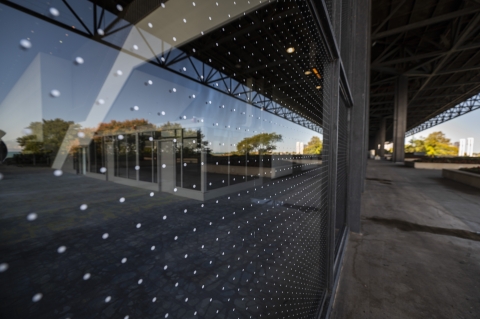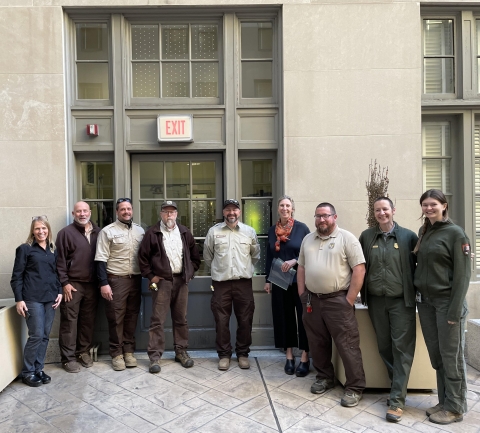Following the February 2024 Multi-Sector Summit to Address Light Pollution and Bird Collisions, the Service has been purposefully working towards voluntary implementation of the primary goal established:
Intentional collaboration with a diverse group of partners to ensure bird-friendly practices are implemented at meaningful scales.
Since that time, the Service and our large collaborative partnership with industries, stakeholders, conservation organizations, academia, local and state agencies, and others, have been leading the movement to take voluntary actions at all scales to address light pollution and stop bird collisions. This movement has gained momentum across the country, from individual homeowners to city skyscrapers.
Here are just a few examples highlighting the partnerships and voluntary conservation work that is happening all across the country:
McCormick Place Lakeside Center in Chicago
After a collision event where nearly 1,000 migratory birds died during one night in October 2023, several conservation organizations provided a suite of recommendations to McCormick Place to reduce the risk of future similar events. Experts at U.S. Fish and Wildlife Service also reached out to offer technical assistance, and helped their staff to clarify and prioritize actions to make their glass visible to birds and reduce light emanating from the facility that can attract and disorient birds. The McCormick Place leadership and board of directors expressed their commitment to implement lasting solutions to reduce and ideally prevent collisions at their facilities and has followed through on that commitment. They have implemented a “curtains-closed-by-default” policy at the event center, which prevents light from escaping much more frequently than their previous approach. Additionally, and most impressive, during the summer of 2024 they installed nearly 120,000 square feet of a 2” x 2” dot pattern developed by Feather Friendly, making nearly 2 football fields of glass bird-friendly! Preliminary monitoring results by the Chicago Field Museum illustrate that these actions worked very well during the 2024 fall migration.
University of Pittsburgh Medical Center
The University of Pittsburgh Medical Center Presbyterian Tower will be a destination for health and wellness, where people come to heal. It is the largest construction project ever undertaken at the University of Pittsburgh Medical Center and is full of firsts! Through partnerships with the Carnegie Museum of Natural History, and Hammel, Green and Abrahamson, a national firm specializing in commercial architecture, engineering, and interior design, they have installed bird-safe glass on the new Presbyterian tower. The installation features glass with vertical lines silkscreened on the outer surface at 4-inch intervals along the first three stories, extending from street level to the rooftop gardens, to help reduce bird-window collisions. The collaboration with the Carnegie Museum of Natural History to install bird-safe glass is just one example of the University of Pittsburgh Medical Center's commitment to make this project more than just a building.
Viking Expedition Ships Octantis and Polaris
We also have partners engaged in voluntary conservation efforts offshore, where birds are still impacted by light pollution and collisions with structures. Viking Cruises operates two expedition cruise ships in its fleet that implement proactive measures to reduce lighting and the risk of attracting and disorienting birds to the ships’ decks. “Bird mode” is activated during migration periods and when the ship is near sensitive bird areas; ship operators dim lights on the decks, automatically close window blinds, and draw curtains in communal areas. Passengers are informed before the ship goes into “bird mode” and are provided educational information on the actions. Reducing lighting on ships and offshore structures, similar to “bird mode” presents a significant conservation opportunity for our partnership to pursue.
Petrified Forest National Park
Up until recently, instead of cleaning the Painted Desert Community Complex windows at Petrified Forest National Park, staff would leave soap on the windows to prevent bird strikes! The Petrified Forest was certified as a Dark Sky Park in 2018 and already turned off lights in the Complex at night, but the glass surrounding the Complex courtyard created a potentially lethal environment for birds during the day. The long-term solution will be to replace window glass with etched glass as part of a rehabilitation project at the Complex. To reduce bird collisions during the interim years, the park applied a film to the windows that birds can see. Now the windows sparkle and birds avoid them, making the courtyard safer for birds and more enjoyable for visitors.
Learn more about how the National Park Service is making the parks safer for birds.
Stewart Lee Udall Building in Washington, D.C.
In partnership with the Department of Interior’s Facilities and Administrative Services, and the General Services Administration, we were very excited to be offered to the opportunity to create two bird-safe window demonstration areas in the historic Stewart Lee Udall Building in Washington, D.C., the home of the Department of the Interior. U.S. Fish and Wildlife Service Director Martha Williams communicated the importance of making the building more bird-friendly and worked to make sure the blinds are closed throughout the building to prevent light spillover during the night. The Director helped apply window treatments to make the glass visible to birds during the day. This trial installation at the building is the first step toward making the Stewart Lee Udall Building windows safer for birds, with the potential to expand on these efforts and install more in the future.










